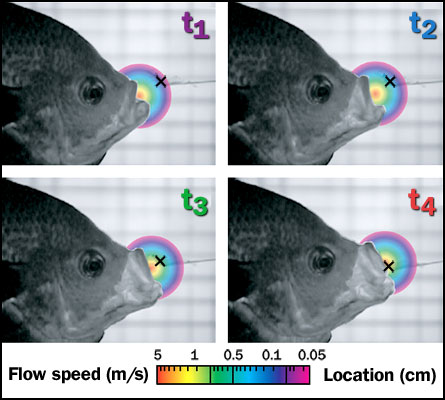- More than 2 years ago
When sucking up small prey, many fishes look like they’re sticking their lips out. This kiss-of-death gesture — actually done by mobile upper- and lower-jaw bones — dramatically increases the fish’s suction power, researchers have now found, lowering the prey’s chances of escape.

The results may help explain the evolutionary advantage of the diverse types of extendable jaws sported by as many as half of all fish species. “From this work, it is clear that the success of a prey-capture event could strongly depend on the ability of a fish to protrude its jaws,” comments Timothy Higham of HarvardUniversity.
Peter Wainwright of the University of California, Davis and his collaborators fed live ghost shrimp to bluegills (Lepomis macrochirus) in a lab tank and recorded the fish’s chomps at 500 frames per second. At the same time, the team scattered laser light off particles suspended in the water. Researchers then used computer software to track the motion of the fish, the prey and the particles in the surrounding water. From that, the team was able to measure the forces exerted on the shrimp.
As the bluegills sucked water in, they quickly protruded their jaws forward, which made their prey flow faster into their mouths. But the data showed that the speed of the fish jaws, which extend in just tens of milliseconds, was not the whole story.
Just like a vacuum extension tube helps suck dust from hard-to-reach corners, the fish extend out their mouths to get their best suction power right where their potential snack is. “When they protrude their jaws, they move the part where the flow is faster toward their prey,” Wainwright says. As water is forced toward and through the fish’s mouth, it speeds up, Wainwright explains. The effect is analogous to how partially covering a garden hose with your thumb creates a spray.
The result of the extending jaws increases the suction force on prey by 35 percent, the researchers write in an upcoming Journal of the Royal Society Interface.
Scientists have known about the trick for years, but this is the first time that anyone has actually measured the forces involved, comments Sam Van Wassenbergh of the University of Antwerp in the Netherlands. Wassenbergh adds that the results demonstrate the advantage of moving the jaws, rather than the entire body. “One way would be to swim at the prey, but this has the disadvantage of displacing a relatively large amount of water along with your body, which could push away the prey.”
Watch a bluegill sunfish use suction to devour a shrimp:
A bluegill sunfish sucks in an unlucky shrimp. from Science News on Vimeo.
A shrimp twice narrowly escapes a bluegill sunfish’s suction and then surrenders to the fish’s extendable jaws, which place the highest suction power where it’s needed (high-speed video shot at 500 frames per second). Video courtesy of Steven Day.
Watch a bay snook gobble up a smaller fish:
A bay snook gobbling up a smaller fish from Science News on Vimeo.
The bay snook (Petenia splendida), shown here gobbling up a smaller fish, displays an extreme example of jaw protrusion. Up to half of all fish species can extend both their upper and lower jaws forward. (Sequence taken at 500 frames per second.) Video courtesy of Tom Waltzek.







